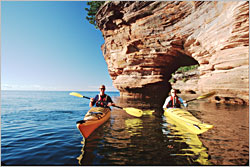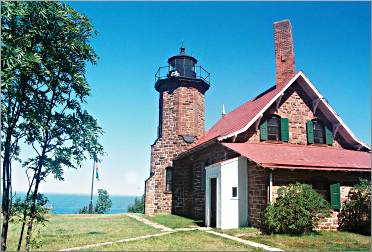Kayaking the Apostles
The wild 21-island archipelago around Wisconsin's Bayfield Peninsula is the preserve of paddlers.

© RJ & Linda Miller
The sky was clear, the wind was still and Lake Superior was as placid as a lily pond.
It was a miracle that wouldn't last.
That's why it was torture for the dozen of us to sit through a long kayak safety course on the sandy beach of Bayfield, Wis., forming a "human knot" to foster cooperation in case of disaster and listening to trip leader Hovas Schall's horror stories about the big, mercurial lake.
"Kayakers play a game with the weather, and the weather always wins," she said darkly. "Sea kayaking is a dangerous sport."
Kayaking, however, was the only way the dozen of us were going to get to see any of the 21 islands of the Apostle Islands National Lakeshore.
Geologists say the Apostles, which rise in picturesque irregularity off Wisconsin's Bayfield Peninsula, were created by scraping glaciers.
But the Ojibwe have another explanation: The great Naniboujou, angry at a beaver, threw rocks into Lake Superior, forming the islands.
Four or five centuries ago, the Ojibwe arrived from the east, driven out by the Iroquois. French explorers arrived in the 1600s, followed by fur traders, whose business revolved around Madeline Island, the largest of the Apostles.
On the other Apostles, the Ojibwe set up summer camps for fishing, hunting and berry-gathering — until the white influx pushed them onto reservations in 1854 and used the islands to supply timber and brown sandstone to build Milwaukee, Chicago and other cities.
But the quarries and logging camps eventually were abandoned, and wilderness returned.
In 1970, one step ahead of developers, Wisconsin Sen. Gaylord Nelson pushed a bill through Congress that made the islands and a 12-mile strip of the mainland into national lakeshore, managed by the National Park Service. Only Madeline remains private.
Today, the lighthouses built to protect Great Lakes shipping are the main reminder of modern commerce.

© Beth Gauper
There are automated light stations on six of the islands. Park-service rangers give tours of the Raspberry Island lighthouse, and volunteers staff the lights at Sand, Devils and Michigan islands. On Manitou Island, a 1930s fish camp has been restored and is staffed by volunteers.
Bits of colorful history swirl around the islands: shipwrecks, hermits, war parties, even pirates and stolen gold.
But it is for the natural history that most come. Visitors hope to catch a glimpse of black bears on Stockton, which has the nation's densest concentration.
They want to see the sea caves, watch rookeries of herons and herring gulls, and hike the miles and miles of trails.
Our little kayaking group was headed for Sand Island, three miles off Little Sand Bay, at the top of the Bayfield Peninsula.
As it turns out, my premonition about the weather was on the money; by the time we set out, gusts had blown in from the northeast and the water was gray and choppy.
Soon, we were sinking into the troughs of waves that neared 4 feet, and our paddle strokes seemed to make puny progress. But finally we were pulling our kayaks onto the narrow beach of Sand Island.
We shared a dinner of grilled whitefish with Gene Wilkens, a park-service volunteer from Texas who was keeping tabs on things: "I saw a black bear last night," he said. "We just looked at each other, said, 'Woo-eee!' and turned around."
Mostly, Wilkens loved to tell stories — about the 1914 fire on the tug Herring King, and the Norwegian fishermen who lived in Shaw, the only village to take root in the Apostles beside La Pointe on Madeline.
And he relished telling the story about the three hot-shot kayakers who, in Wilkens' version of a campfire ghost story, nearly found a watery grave a few yards off Sand one treacherous Memorial Day.
The late-August morning dawned clear and calm, and we took a dip before putting on wetsuits and heading for the sea caves at Swallow Point.
The sun illuminated the dusky reds of the sandstone, and we glided inside, under arches and among rocky pillars that resembled dinosaur shins.

© Beth Gauper
The lapping of the water in the rounded rooms created a hollow gurgling; it was easy to see why the Ojibwe thought the caves had a malevolent character.
After lunch, we hiked along the two-mile trail to the lighthouse, where volunteer keeper Nancy Peterson of Minneapolis gave us a tour of the stone Gothic Revival building she thinks "is absolutely the most beautiful in the Apostles."
From the tower, she pointed out the red buoy that marked the shoals on which the ore freighter Sevona foundered in 1905.
"There were 25-foot waves, and the boat was broken in half," she said. "The crew jury-rigged a life raft and got within 100 yards of Justice Bay, but the raft broke and they all drowned. The keeper's journal shows they looked for seven bodies and finally found them on Oct. 2, a month later."
On the way back to camp, Schall showed us the difference between a thimbleberry and a raspberry, hugged a tree and talked about her favorite islands — Devils for its huge blueberries, Bear for underwater sea caves, Raspberry for its lighthouse tour.
But Sand, she said, has a little of everything.
"This is an interesting island, it really is," Schall said. "If it weren't for the National Park Service, it might be condominiums."

© Torsten Muller
Trip Tips: Kayaking the Apostle Islands of Wisconsin
What to know: If you paddle without a professional guide, wear (not just bring) a wetsuit and life jacket.
The park service recommends other items to bring, including a marine radio, and what you need to know.
It's very important to check the weather forecasts before setting out. Conditions can change quickly.
Sea caves: There are caves on the rocky shores of Devils Island, Sand Island and on the mainland near Meyers Beach.
Kayakers heading for the mainland sea caves should check SeaCavesWatch.org for the real-time wave height at the caves, where cliffs reflect and amplify waves. Large waves can be very dangerous for paddlers, and conditions cannot be seen from the Meyers Beach put-in.
In winter, they are famous for ice formations. For more, see Ice caves of the Apostles.
Outfitters: Rustic Makwa Den in Red Cliff offers guided kayaks tours of the Meyers Beach, Red Cliff and Sand Island sea caves and also rents kayaks to those who can demonstrate proficiency.
Lost Creek Adventures in Cornucopia offers half-, full- and multi-day tours of the islands and sea caves and also rents kayaks.
Trek and Trail in Bayfield offers day trips and overnights to the islands.
The nonprofit Wilderness Inquiry of Minneapolis offers three- and five-day Apostles kayaking trips, and people with disabilities are welcome on them.
Camper shuttles: The Apostle Islands Cruise Service offers camper/kayaker shuttles to Stockton and Oak islands.
Camping: Camping is allowed on 19 islands. Permits cost $15 per night for individual campsites, which can be reserved 30 days in advance, plus a $10 reservation fee. Group sites for eight to 21 campers cost $30 per night and can be reserved the second week of January.
Apostle Islands National Lakeshore Visitors Center: It's in Bayfield's old county courthouse, Washington Avenue and Fourth Street. It's open daily from Memorial Day weekend through September and weekdays in May and the first two weeks of October.
Kayak launches: It's free at Meyers Beach, from which many kayakers paddle a mile east to see the Mawikwe Bay mainland sea caves, and from Little Sand Bay. There's a $5 parking fee at Meyers Beach.
Lighthouses: There are eight light stations on six islands; two are retired.
For more, see Lighthouses of the Apostles.
Bayfield: Bayfield tourism, 800-447-4094. For more, see Beloved Bayfield.
For more about Madeline Island, see Madeline's magnetism.